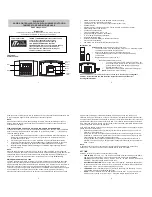
Problem
Things to Try
The display is too bright at
night.
Adjust the backlight brightness level.
Turn off the radio; hold
CALL-MENU
button and turn it
back on (see page 19).
I can’t see any words on the
display.
Reset the radio back to the default brightness level: turn off
the radio; hold the
CALL-MENU
button and turn it back on.
I’m not getting any GPS data on
my display.
Make sure your GPS receiver is correctly connected (see
Connecting to a GPS receiver, page 40).
Make sure your GPS receiver is working properly.
Make sure that your GPS receiver supports the NMEA
parameters described in NMEA Operation on page 41.
I’m not getting any hazard alerts.
Make sure Weather Alert Watch is turned on.
Check to make sure the FIPS codes in your radio include
your current location (see Using FIPS codes for weather
alerts on page 17).
I’m getting all the hazard alerts,
not just the ones for my area.
Check to make sure the FIPS codes in your radio were
entered correctly (see Using FIPS codes for weather alerts
on page 17).
Sometimes the Weather Alert Watch may catch a hazard
alert in the middle of the broadcast and miss which FIPS
codes are affected. For your safety, the radio triggers the
alert tone and switches to the weather channel when this
happens.
I can’t make Group DSC calls.
Make sure the Group MMSI was entered correctly.
Where can I find my radio’s
serial number?
Look on the right side of the radio (the side with the
microphone cord), behind the mounting bracket.
The radio won’t let me enter my
User MMSI. What do I do?
Contact customer service.
Engine Noise Suppression
Interference from the noise generated by the electrical systems of engines is sometimes
a problem with radios. Your radio has been designed to be essentially impervious to
ignition noise and alternator noise. However, in some installations it may be necessary
to take measures to further reduce the effect of noise interference. Your radio’s DC battery
VHF585 RADIO
1-800-BOATING
45
















































